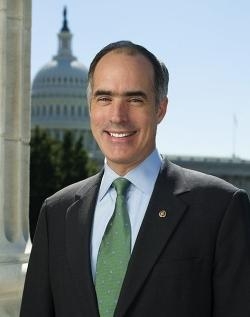Fri, Sep 13, 2013
Aim Is To Protect Cockpits Of Commercial Aircraft
U.S. Senator Bob Casey (D-PA) has introduced the Saracini Aviation Safety Act of 2013 which would require each commercial aircraft to install a barrier, other than the cockpit door, to prevent access to the flight deck of an aircraft. The legislation is named after Bucks County resident Captain Victor Saracini who piloted United Flight 175 when it was hijacked by terrorists and flown into the World Trade Center. While cockpit doors are currently reinforced, a secondary barrier will protect passengers and crew during times in flights when cockpit doors are opened. The bill has been introduced in the House of Representatives by Congressman Michael Fitzpatrick (R-PA) and has 45 bipartisan cosponsors. The bill is also endorsed by the Airline Pilots Association, Allied Pilots Association and the Federal Law Enforcement Officers Association.

“We’ve made progress on airline safety in the years since September 11th 2001 but there are still additional common-sense steps we can take better protect passengers and flight crew,” Senator Casey said. “There’s no way to fully and completely honor the extraordinary courage of Captain Saracini. He gave the full measure of his life for our nation, and his wife, Ellen, and his family have worked tirelessly in the years since to increase airline safety. I’m urging Congress to pass this legislation to make further improvements to airline safety.”
In the aftermath of September 11th, Congress mandated the installation of reinforced cockpit doors, and the FAA issued regulations that stated that these reinforced doors should remain locked while closed. While this is a step in the right direction, these doors are often opened and closed several times during flights, putting airline pilots, crew, and passengers at risk. Due to budget cuts and sequestration, many of the federal programs designed to increase aviation safety, such as the Federal Flight Deck Officer program, are facing funding shortages. These factors show that our airlines are still vulnerable to potential terrorist attacks.
The Saracini Aviation Safety Act would address this problem by requiring each commercial aircraft to install a barrier, other than the cockpit door, to prevent access to the flight deck of an aircraft. It would also require that the barriers remain locked when the aircraft is in flight and the cockpit door is open. Lastly, it would give pilots of planes without cockpit doors, discretion on when they would like to lock the barrier during flight. This would provide a cost-effective, safe way to have additional security for our nation’s pilots, airlines, and passengers.
A secondary cockpit barrier is a light weight wire-mesh gate installed between the passenger cabin and cockpit door that is locked into place and blocks access to the flight deck. In 2003, a voluntary airline industry movement toward adopting secondary barriers began, but deployment of the devices waned. The barriers provide significantly more security to airline companies, their employees, and passengers. A 2007 study conducted at the request of the Airline Pilots Association International and the airline industry concluded that secondary cockpit barrier doors are the most cost-effective, efficient, and safest way to protect the cockpit.
Similar legislation was previously introduced in the U.S. House of Representatives.
More News
Also: SkyReach Parts Support, Piper Service Ctr, Airliner Near-Miss, Airshow London The Judge overseeing Icon's convoluted Chapter 11 process has approved $9 million in Chapter 11 >[...]
ILS PRM Approach An instrument landing system (ILS) approach conducted to parallel runways whose extended centerlines are separated by less than 4,300 feet and at least 3,000 feet >[...]
Aero Linx: FlyPups FlyPups transports dogs from desperate situations to fosters, no-kill shelters, and fur-ever homes. We deliver trained dogs to veterans for service and companion>[...]
Also: Skydio Chief, Uncle Sam Sues, Dash 7 magniX, OR UAS Accelerator US Secretary of the Air Force Frank Kendall was given a turn around the patch in the 'X-62A Variable In-flight>[...]
Also: NBAA on FAA Reauth, DJI AG Drones, HI Insurance Bill Defeated, SPSA Airtankers The Beechcraft Denali continues moving forward towards certification, having received its FAA T>[...]
 Airborne 05.10.24: Icon Auction, Drunk MedEvac Pilot, Bell ALFA
Airborne 05.10.24: Icon Auction, Drunk MedEvac Pilot, Bell ALFA ANN's Daily Aero-Term (05.13.24): ILS PRM Approach
ANN's Daily Aero-Term (05.13.24): ILS PRM Approach ANN's Daily Aero-Linx (05.13.24)
ANN's Daily Aero-Linx (05.13.24) Airborne-NextGen 05.07.24: AI-Piloted F-16, AgEagle, 1st 2 WorldView Sats
Airborne-NextGen 05.07.24: AI-Piloted F-16, AgEagle, 1st 2 WorldView Sats Airborne 05.08.24: Denali Update, Dad-Daughter Gyro, Lake SAIB
Airborne 05.08.24: Denali Update, Dad-Daughter Gyro, Lake SAIB



